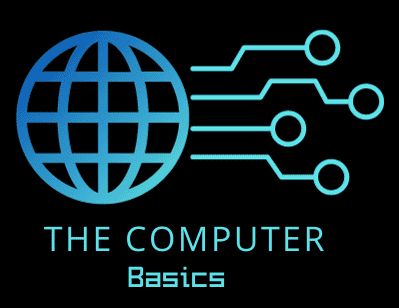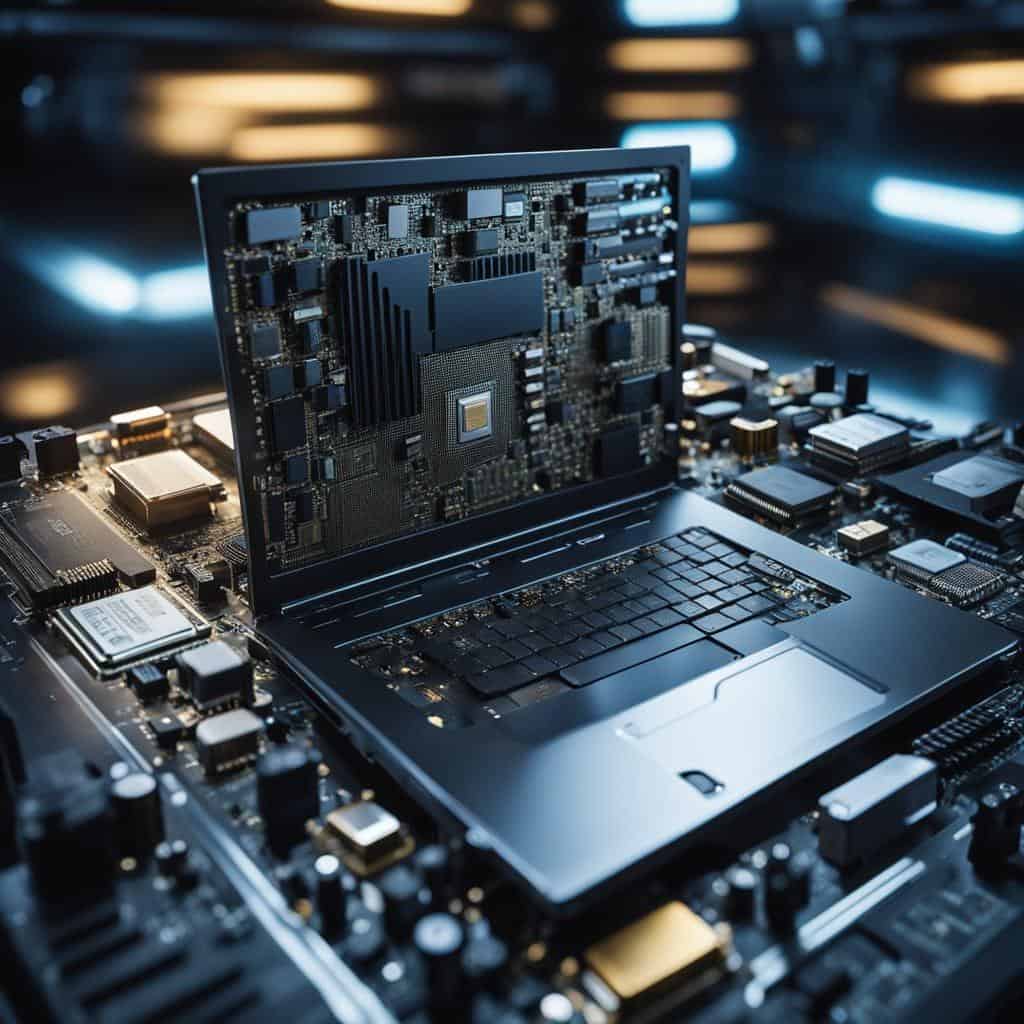TL;DR:
- The laptop motherboard connects all hardware and control parts such as the processor and heatsinks.
- Different chipsets facilitate communication between the processor and other elements at varying speeds, resulting in varied graphic and power performances.
- Each component on the motherboard serves unique roles; system fans cool the system and connect to the motherboard with control/power cables.
- The CPU, or the “brain” of the laptop, executes instructions, performs calculations, and manages data while energy-efficient CPUs conserve battery.
- The GPU, essential in rendering images, animations, and videos, takes details from the CPU and delivers visuals.
- SSDs provide faster, quieter, but more costly storage, while HDDs offer larger but slower storage spaces at a cheaper cost.
- Failed hard drives can be replaced by careful unmounting and mounting of a new one.
- RAM is vital for speeding up laptop performance and is easy to upgrade within system limits.
- Laptop cooling systems comprise fans and heatsinks; maintaining them involves cleaning and proper placement, with aftermarket solutions, like cooling mats, available.
- Audio components, while enhancing the media consumption experience, can be upgraded with compatible parts.
- Laptops contain various connectivity modules: wireless cards for internet connectivity, internal network cards for interpersonal laptop communication, and others like Bluetooth and GPS modules.
Ready to unravel the mystery of your laptop’s internals? Join us as we embark on a comprehensive exploration of laptop components – from the core of the motherboard to the intricacies of the GPU. Our in-depth guide uncovers not just what’s under your keyboard but also the relevance and functionality of each part. We’ll decode chipset differences, tackle troubleshooting, and burrow into the brain of your machine – the CPU. Read on and master your tech like never before!
What are the Key Components of a Laptop Motherboard?
A laptop’s heart is its motherboard. It connects and controls all hardware. Each smaller part on this king-sized circuit card plays a key role.
Let’s dive into what these components do. For example, the processor, or the “brain” of your laptop, is affixed on the motherboard. Then, the distinct metallic fins are known as heatsinks. They work under a shroud with a fan directing heat away from the processor. Heatsinks attach firmly to the motherboard with screws.
What are the different chipset differences?
Different chipsets perform tasks at various speeds. They are the go-between for the processor and other elements. Some chipsets offer more functions such as improved graphics or better power management.
How to troubleshoot laptop motherboard problems?
Detecting motherboard problems can be tricky. Symptoms can vary, such as your laptop not turning on, the system crashing, or overheating. One way to check is by running a diagnostic test with software. However, due to the complexity, it’s often best to see a professional for this.
What does each component on a laptop motherboard do?
Every component serves a unique purpose. For instance, we have system fans. Look for the generally black fans that cool the system. They connect to the motherboard with a control/power cable and typically use rubber clips or a cage for stability. Each part is essential for your laptop’s performance and efficiency. So it’s important to understand their roles.
Keep in mind this article aims to inform. If you face problems, be sure to contact local support. They can offer assistance tailored to your specific laptop. Don’t forget, that every laptop has unique features, hence, variations in components might be there.
How Do Laptop Processors Work?
You may wonder, what’s the deal with the central processing unit (CPU) in laptops? Well, think of the CPU as the brain of your laptop. It handles instructions, performs calculations, and manages data. It does all the work!
How Does a CPU Function Within a Laptop?
In simple words, a CPU takes inputs, processes the data, and then gives outputs. It follows a set of instructions, called a program, and it does this very quickly, millions of times a second!
Are Energy-Efficient CPUs Beneficial for Laptops?
Absolutely! Energy-efficient laptop CPUs are superheroes. They perform great tasks using less power. This helps save your laptop’s battery life, giving you more time to work or play.
How to Choose the Right CPU for Your Laptop?
Finding the perfect CPU can be a puzzle, but don’t worry, here’s a detailed guide to laptop processors. First, understand your needs. If you’re gaming or editing videos, go for a high-performance CPU. For general use like browsing or word processing, a basic CPU will do. Remember, your choice affects your laptop’s speed, performance, and battery life. Choose wisely!
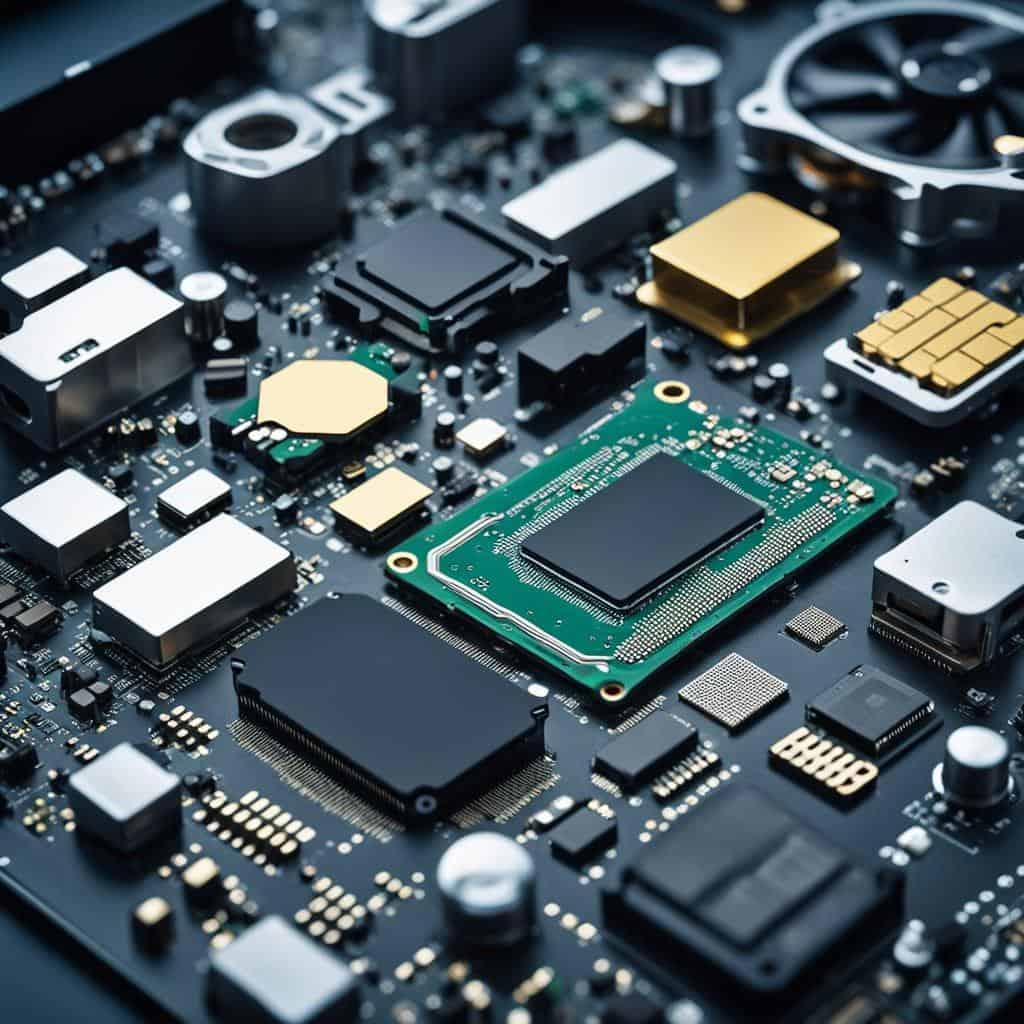
How does a Laptop’s Graphical Processing Unit (GPU) Function?
If you dig into the magic box that’s your laptop, you’ll find a key player called the Graphics Processing Unit, or GPU. This unsung hero takes on the heavy task of rendering images, animations, and videos to your laptop screen. It’s what fuels your games, delivers your movies, and makes all your digital art come to life.
What is the role of a GPU in a laptop?
Now, let’s unwrap the mystery – what is the role of a GPU in a laptop? It’s simple. The GPU’s job is to translate data into a signal your display can understand. It takes details about color, position, and texture from the CPU and figures out what your games, videos, and graphics should look like. Without a GPU, your laptop would be lost in translation!
How to diagnose GPU failures?
Not all is sunshine with GPUs though. Sometimes, they fail. But don’t worry, you can find signs. Are graphics not appearing correctly? Maybe random pixelation or crashing programs? These are all cries for help from your GPU. Diagnosis may be as simple as updating your drivers, or you might need to replace the card entirely. Take it step by step, and you’ll have that GPU humming nicely in no time!
Which is Better for Laptops – SSDs or HDDs?
Laptop storage can seem complex. We have Solid-State Drives (SSDs) and Hard Disk Drives (HDDs). But what’s the big deal about them? Let’s think of SSDs and HDDs like speed racers.
What are the differences between SSDs and HDDs in terms of laptop performance?
SSDs are like sports cars – sleek, fast, and silent. They’re costly but perform better, making your laptop start up and load programs quicker.
On the other hand, imagine HDDs as heavy trucks. They’re bigger, noisier, and slower compared to SSDs but they can haul more data at a lower price.
How does storage capacity affect laptop performance?
Storage capacity is like the fuel for our speed racers. More fuel, or storage, means more data can be stored. But, a larger HDD or SSD doesn’t mean a faster laptop. It’s more about how much stuff you can store.
How to choose the right internal storage for your laptop?
Choosing between an SSD and an HDD depends on what you want. If speed is your goal, an SSD may be the best choice. If you need to store a lot of data and cost matters, an HDD could be your champion.
Remember, you’re the race director. You get to decide which racer is right for your laptop.
How Do I Replace My Laptop Hard Drive?
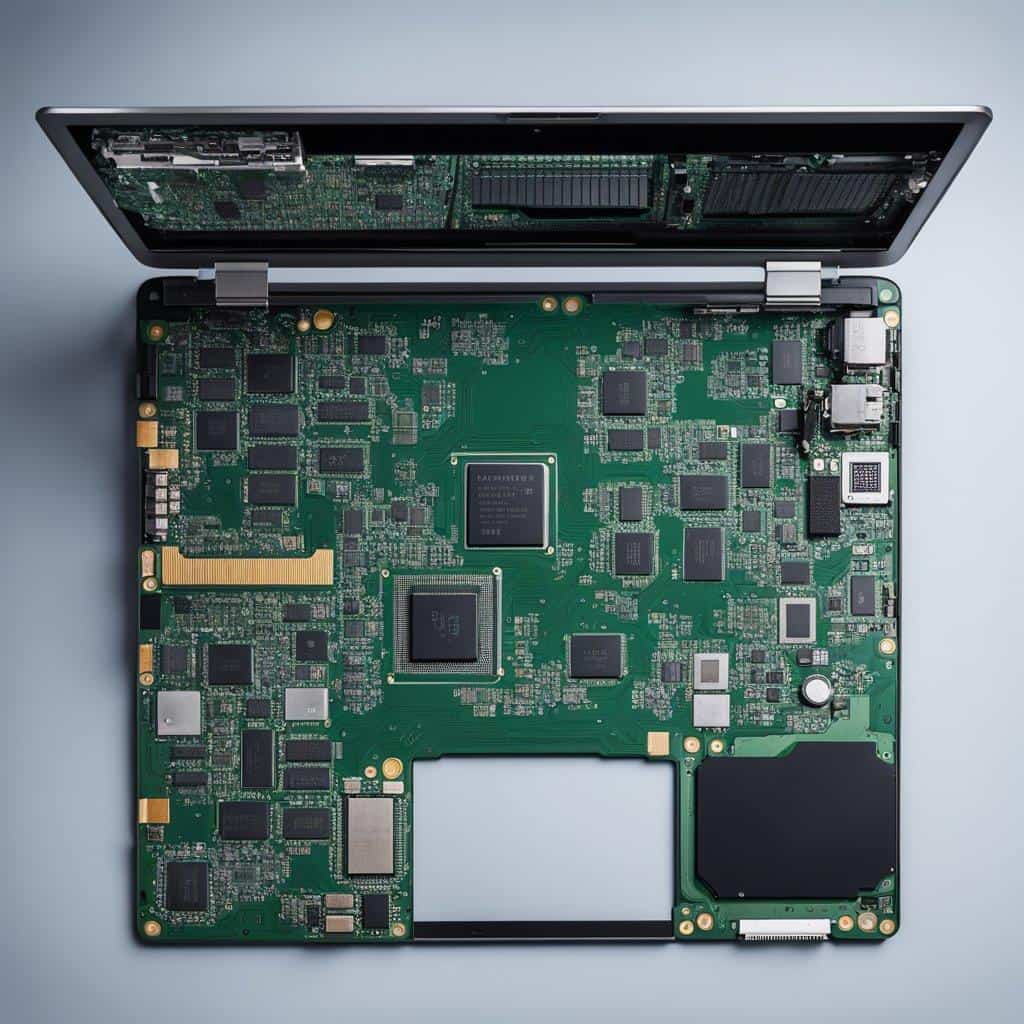
What are the signs of a failing laptop hard drive?
If your laptop slows down or crashes often, these could be symptoms of a failing hard drive. Data corruption or missing files can also indicate a problem.
How to safely replace a laptop hard drive?
Replacing a laptop hard drive requires careful steps. Turn off your laptop, and unplug it. Use anti-static gloves and remove the laptop’s bottom cover. Locate the hard drive, often secured in place by screws. When these are removed, you can slide out the hard drive.
Now you’re ready to insert the new drive. Just slide it in where the old one used to be, re-screw it in place, and replace the cover. Powering up your laptop should now reveal that you’ve successfully replaced your hard drive.
For more in-depth guidance, Dell’s official page offers a helpful guide.
Remember, take your time, and don’t force anything. Laptop components are delicate so handle with care!
What is Random Access Memory (RAM) and How Do I Upgrade It?
So, what is RAM? It’s a key part of your laptop. RAM, or Random Access Memory, is where data gets stored for quick access. This speedup makes your laptop run faster. It’s like a fast temporary workspace for data. More RAM means your laptop can juggle more tasks at once.
Why is it crucial for laptops? Remember, a laptop is a small space. RAM must be compact but powerful to fit. Plus, it helps your laptop perform at its best.
Now, let’s talk about upgrading RAM. Have no fear, it’s simple. The first step, check your laptop’s max RAM limit. Some models have an upper limit, so don’t buy more than you can use. Next, find the right kind of RAM for your laptop. Finally, replace the old RAM module with the new one. It’s a plug-in job, you got this!
Choosing the right RAM for a performance boost? Here’s the secret. More gigabytes (GB) equals more power. But remember, quality matters too. Seek out good brands, they are worth it.
To wrap up, RAM is vital in any laptop. Upgrading is easy and well worth it. Aim for more RAM with quality to give your laptop a real boost. So dive in! Gain the benefits of upgraded RAM It’s an easy upgrade with a big impact.
What Are The Different Types Of Laptop Cooling Systems and How To Maintain Them?
The “coolness” of a laptop rests on two fronts – fans and heatsinks. Fans whirl air around, guiding it into your laptop’s vents. Heatsinks, columns of metal, soak up heat and bid it goodbye. Together, they wrestle laptop heat, keeping it in check. These two types form the backbone of laptop cooling system maintenance.
But what if the heat gets out of hand? Don’t panic. Solving laptop overheating issues starts with basics. Cleaning your cooling systems regularly keeps them efficient. Keeping your laptop on flat surfaces ensures proper airflow. Deep dives into software like power settings can reduce heat generation.
Then there are aftermarket cooling solutions for laptops. Add-on fans, and cooling mats, they promise cooler laptops. But they’re hit-and-miss, based on your laptop’s setup. Some see results, others don’t. Research before you leap into the aftermarket pool.
Remember, a cool laptop is a happy laptop. Regular upkeep of your cooling systems guarantees your laptop laughs in the face of overheating menace.
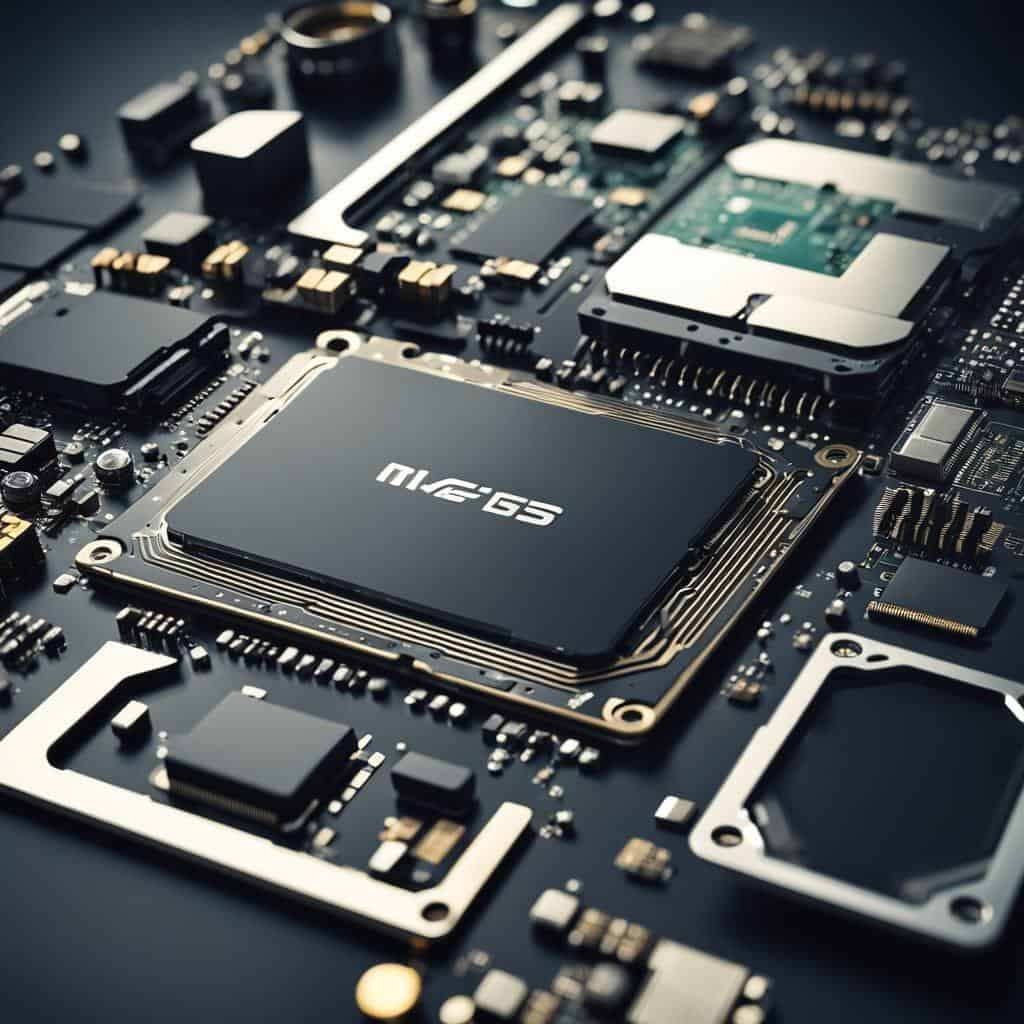
How Important Are The Audio Components In A Laptop?
If you’re a music lover, you know laptop audio matters a lot. But what role do audio components play in a laptop’s performance? Well, a lot. Bullseye answers using the Stanford Question Answering Dataset (SQuAD) method: They enable sound output directly affecting media consumption and user experience. Audio components ensure you hear every note of your favorite tunes and experience virtual meetings.
Interested in enhancing your laptop’s audio? It’s doable. You can improve audio by upgrading internal parts. Remember, each laptop is unique. Researching what’s compatible with your device before making any changes is crucial. As with any DIY project, caution is key. You don’t want to turn your valuable laptop into a paperweight.
So next time you listen to your favorite song or join a virtual gathering, remember the powerful audio components working behind the scenes in your laptop!
What Are The Different Types Of Connectivity Modules In A Laptop?
A laptop is a finely-tuned system of components working together. One of these essential parts is the connectivity modules.
First, let’s peek into wireless cards. These devices get your laptop on the internet, connecting to Wi-Fi networks around you. Without it, no Facebook, news sites, or emails.
Next, we have internal network cards. These devices help your laptop speak to other computers, creating networks. You can share files, play multiplayer games, and work collaboratively.
But, guess what? These two are just the tip of the iceberg. Laptops also boast several other connectivity modules like Bluetooth, mobile data capabilities, and sometimes even GPS modules. This ensures your laptop is truly connected in every sense.
Now, doesn’t that make our everyday laptops seem a little more extraordinary?
Conclusion
In sum, knowledge about the different laptop components, their functions, and troubleshooting any related issues is vital to effectively use and maintain your device. This guide offered insights into the intricacies of laptop hardware, from the motherboard to the cooling system. As you endeavor to understand computer technology fully, bear in mind the importance of staying updated on the latest developments, making informed hardware choices, and considering the subtle details in selecting laptop peripherals.
